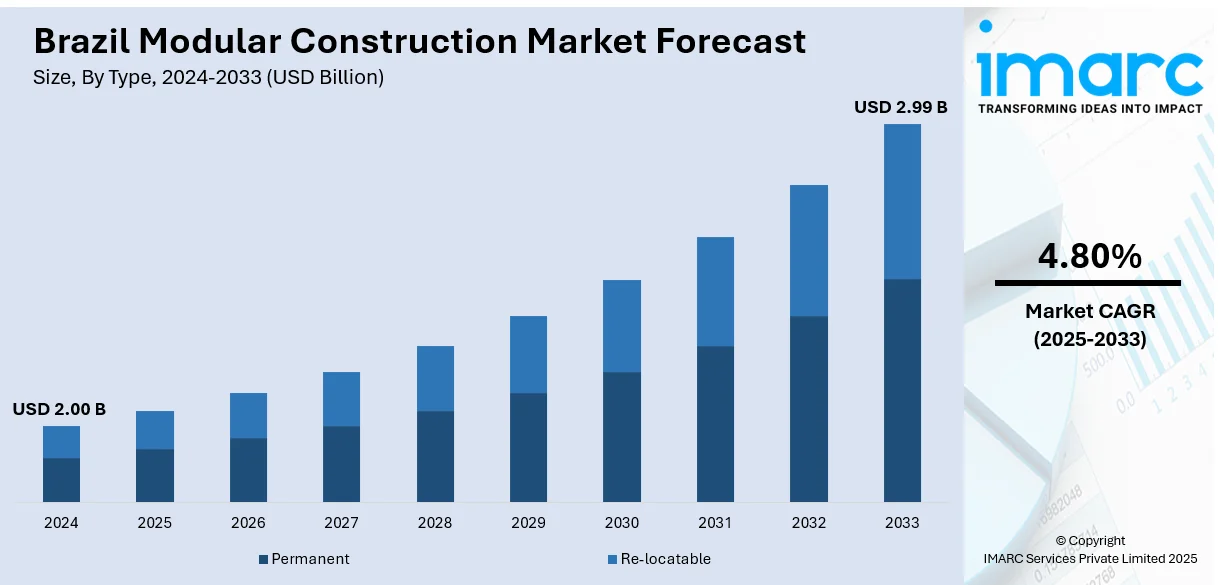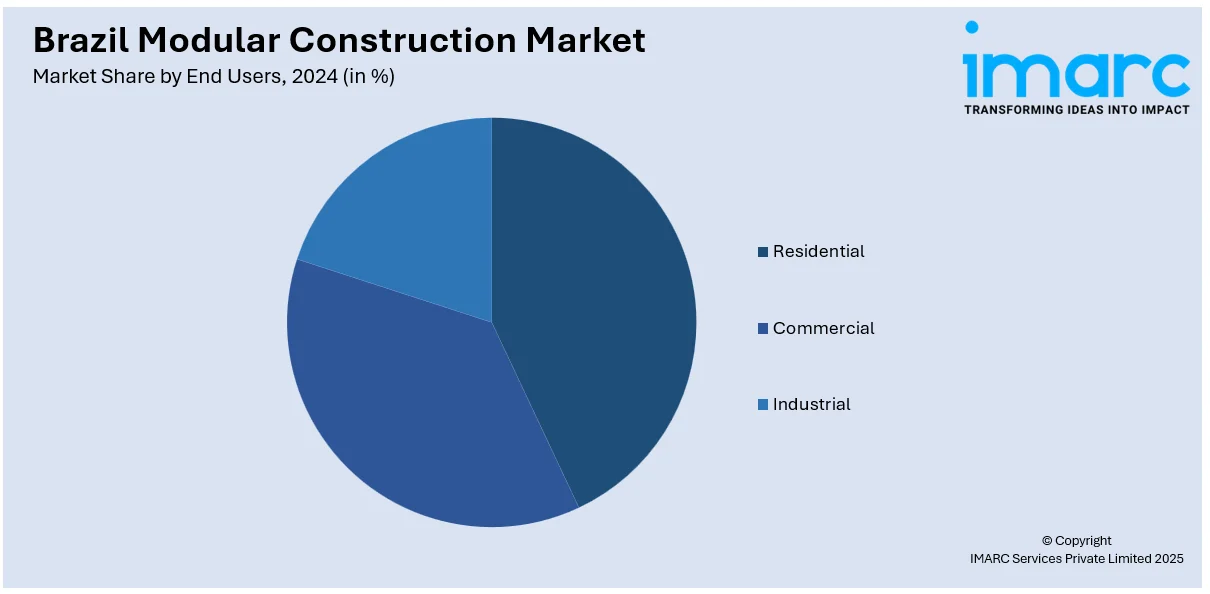
Brazil Modular Construction Market Size, Share, Trends and Forecast by Type, Material, End User, and Region, 2025-2033
Brazil Modular Construction Market Size and Share:
The Brazil modular construction market size reached USD 2.00 Billion in 2024. Looking forward, IMARC Group expects the market to reach USD 2.99 Billion by 2033, exhibiting a growth rate (CAGR) of 4.80% during 2025-2033. The Brazil modular construction market share is expanding due to rising economic demands, infrastructure development, and urbanization. The need for cost-effective, rapid construction solutions is increasing as traditional methods face delays and high costs. Additionally, smart building technologies, energy efficiency, and sustainability initiatives are driving innovation, enhancing modular construction’s market competitiveness and long-term growth.
|
Report Attribute
|
Key Statistics
|
|---|---|
|
Base Year
|
2024
|
|
Forecast Years
|
2025-2033
|
|
Historical Years
|
2019-2024
|
| Market Size in 2024 | USD 2.00 Billion |
| Market Forecast in 2033 | USD 2.99 Billion |
| Market Growth Rate (2025-2033) | 4.80% |
Brazil Modular Construction Market Trends:
Economic and Infrastructure Needs
The modular construction sector is greatly impacted by Brazil's rising economic requirements and infrastructure growth necessities. The pressing need for cost-effective and rapid construction techniques is driven by the extensive urbanization and industrialization occurring in the nation. The CIA reports that as of 2023, 87.8% of Brazil's entire population lived in urban regions. This swift movement to urban areas puts significant strain on the housing sector, necessitating quicker and more affordable construction methods. Traditional construction techniques frequently face extended project durations, elevated labor expenses, and supply chain issues, leading to postponed builds and increased total costs. Conversely, modular construction provides an efficient method by allowing the off-site assembly of building parts, decreasing labor needs, and facilitating quicker project finishes. With Brazil's urban population steadily increasing, especially in cities like São Paulo and Rio de Janeiro, the effectiveness of developing housing and commercial spaces becomes essential. Moreover, modular construction reduces material waste, decreases environmental effects, and enhances quality control, rendering it a practical and sustainable option for the nation’s growing infrastructure demands.

Increased Demand for High-Performance and Smart Buildings
The growth of high-performance and intelligent buildings is fueling innovation in Brazil's modular housing sector. For example, in 2024, Tuya Smart revealed a collaboration with Hometree Casa Inteligente LTDA, the top smart home provider in Brazil. The partnership sought to improve convenience, safety, and energy efficiency, establishing a new standard in Brazil's smart home sector. In addition, developers are incorporating intelligent technologies like energy-saving heating, ventilation, and air conditioning (HVAC) systems, internet of things (IoT)-enabled sensors, and automated lighting into modular buildings to improve performance and lower operational expenses. Modular building allows for the smooth incorporation of these technologies during the manufacturing process, guaranteeing accuracy, productivity, and uniformity in installation. The regulated surroundings of modular construction decrease the chances of mistakes and setbacks, enabling improved building design that enhances energy savings and resource effectiveness. Moreover, progress in material science and digital building techniques is improving the longevity and eco-friendliness of modular buildings. The increasing consciousness regarding energy efficiency, eco-friendly building materials, and innovative insulation methods is establishing modular construction as a crucial participant in the development of smart infrastructure. The incorporation of data-oriented monitoring systems and automation enhances building management, maximizing energy efficiency and maintenance plans. With businesses, government entities, and homeowners looking for connected, efficient, and sustainable building solutions, the demand for modular construction is rising, strengthening its market viability and long-term integration across multiple sectors.
Brazil Modular Construction Market Segmentation:
IMARC Group provides an analysis of the key trends in each segment of the market, along with forecasts at the regional level for 2025-2033. Our report has categorized the market based on type, material, and end user.
Type Insights:
- Permanent
- Re-locatable
The report has provided a detailed breakup and analysis of the market based on the type. This includes permanent and re-locatable.
Material Insights:
- Steel
- Wood
- Concrete
- Others
A detailed breakup and analysis of the market based on the material have also been provided in the report. This includes steel, wood, concrete, and others.
End Users Insights:

- Residential
- Commercial
- Industrial
A detailed breakup and analysis of the market based on the end users have also been provided in the report. This includes residential, commercial, and industrial.
Regional Insights:
- Southeast
- South
- Northeast
- North
- Central-West
The report has also provided a comprehensive analysis of all the major regional markets, which include Southeast, South, Northeast, North, and Central-West.
Competitive Landscape:
The market research report has also provided a comprehensive analysis of the competitive landscape. Competitive analysis such as market structure, key player positioning, top winning strategies, competitive dashboard, and company evaluation quadrant has been covered in the report. Also, detailed profiles of all major companies have been provided.
Brazil Modular Construction Market News:
- In December 2024, the Brazilian steel manufacturer CSN has initiated a modular data center at its Presidente Vargas facility in Rio de Janeiro. This project sought to boost automation methods, increase productivity, and avert server failures. The initiative was executed by Gemelo Data Centers, a Brazilian company specializing in modular data centers.
- In January 2023, in Sao Paulo, Brazil, modular construction is poised to transform residential development with a fast-tracked 8-month timeline for a 75-unit mixed-use initiative. The Brazilian modular construction company Modularis aims for the mid-rise project to be a demonstration that increases awareness of innovative construction technology in residential building in Brazil, utilizing its industrial experience and new manufacturing plant to guarantee ongoing growth and achievements.
Brazil Modular Construction Market Report Coverage:
| Report Features | Details |
|---|---|
| Base Year of the Analysis | 2024 |
| Historical Period | 2019-2024 |
| Forecast Period | 2025-2033 |
| Units | Billion USD |
| Scope of the Report |
Exploration of Historical Trends and Market Outlook, Industry Catalysts and Challenges, Segment-Wise Historical and Future Market Assessment:
|
| Types Covered | Permanent, Re-locatable |
| Material Covered | Steel, Wood, Concrete, Others |
| End Users Covered | Residential, Commercial, Industrial |
| Regions Covered | Southeast, South, Northeast, North, Central-West |
| Customization Scope | 10% Free Customization |
| Post-Sale Analyst Support | 10-12 Weeks |
| Delivery Format | PDF and Excel through Email (We can also provide the editable version of the report in PPT/Word format on special request) |
Key Questions Answered in This Report:
- How has the Brazil modular construction market performed so far and how will it perform in the coming years?
- What is the breakup of the Brazil modular construction market on the basis of type?
- What is the breakup of the Brazil modular construction market on the basis of material?
- What is the breakup of the Brazil modular construction market on the basis of end user?
- What is the breakup of the Brazil modular construction market on the basis of region?
- What are the various stages in the value chain of the Brazil modular construction market?
- What are the key driving factors and challenges in the Brazil modular construction market?
- What is the structure of the Brazil modular construction market and who are the key players?
- What is the degree of competition in the Brazil modular construction market?
Key Benefits for Stakeholders:
- IMARC’s industry report offers a comprehensive quantitative analysis of various market segments, historical and current market trends, market forecasts, and dynamics of the Brazil modular construction market from 2019-2033.
- The research report provides the latest information on the market drivers, challenges, and opportunities in the Brazil modular construction market.
- Porter's five forces analysis assist stakeholders in assessing the impact of new entrants, competitive rivalry, supplier power, buyer power, and the threat of substitution. It helps stakeholders to analyze the level of competition within the Brazil modular construction industry and its attractiveness.
- Competitive landscape allows stakeholders to understand their competitive environment and provides an insight into the current positions of key players in the market.
Need more help?
- Speak to our experienced analysts for insights on the current market scenarios.
- Include additional segments and countries to customize the report as per your requirement.
- Gain an unparalleled competitive advantage in your domain by understanding how to utilize the report and positively impacting your operations and revenue.
- For further assistance, please connect with our analysts.
 Inquire Before Buying
Inquire Before Buying
 Speak to an Analyst
Speak to an Analyst
 Request Brochure
Request Brochure
 Request Customization
Request Customization




.webp)




.webp)












